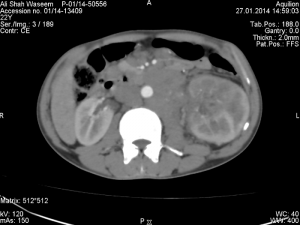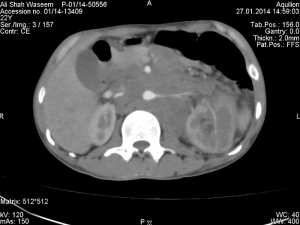This is a case scenario of a young male patient with fever, flank pain, and swollen lymph nodes. This case scenario has a theme which will be discussed later.
Case scenario of the patient with fever, and swollen lymph nodes…
A 22 years old male patient, a laborer by profession, was admitted in our hospital via the OPD with the following complaints:
- Left flank pain for three months and
- Fever for the last 25 days
The patient was alright three months back when he had pain in the left flank which gradually progressed in intensity over time. He described the pain as a constant, and severe in intensity ( graded 8/10 on the pain scale), and radiated to the groin. The pain was associated with nausea and vomiting and he would temporarily get relief with pain medications.
The patient denied blood or pus in the urine. He also denied any history of painful urination or altered bowel habits.
The fever was low grade with intermittent spikes. There was no history of night sweats but he had a marked weight loss over these three months. The patient also had anorexia, fatigue, malaise, and dry cough.
The patient is an occasional smoker, unmarried and belongs to a low socioeconomic status.
He has been repeatedly visiting a urologist for the flank pain and fever. He has been getting treatment for nephrolithiasis and urinary tract infection. Over the past three months, he took analgesics and multiple courses of antibiotics without any significant relief.
On examination:
He is a young male, with the following vital signs:
- Pulse: 112/minute,
- Blood pressure: 120/70 mmHg
- Temp: 100 F and Normal respiratory rate
- He is pale but not jaundiced.
He has Left anterior cervical, b/l supraclavicular and inguinal lymphadenopathy.
- The abdomen is soft, but tender in the left lumbar region with a palpable left kidney.
- Liver span 14 cm, non-tender, soft in consistency with regular margins.
- Spleen is not palpable
- Other Systemic examination is normal.
Investigations of the patient
The following investigations were carried out
- Blood CP and ESR
- Complete blood chemistry
- Urine R/E
- Ultrasound Abdomen
- FNAC of lymph node
- CT Scan Abdomen
Results of the Investigations:
- Blood CP:
- Hb: 10.8 gm/dl
- TLC: 6000/ul
- Platelets: 467000/ul
- ESR: 72 mm
- Alkaline phosphatase: 127 mg/dl
- Urea: 21 mg/dl
- Creatinine: 0.98 mg/dl
- Serum electrolytes and ALT: Normal
- Hepatitis profile: normal
- Urine R/E:
- RBCs: Nil
- WBCs: 2-3/HPF
Ultrasound Abdomen:
- Abdominal lymphadenopathy
- Left kidney is swollen, echogenic with mild hydronephrosis and proximal hydroureter
CT scan of the chest and Abdomen:



- Appearance is suggestive of lymphoma,
- pulmonary metastasis,
- infiltration of left kidney and
- a possibility of left renal vein thrombosis
FNAC (Fine needle aspiration cytology) of the supraclavicular lymph node:
Moderately cellular with clusters of atypical cells having pleomorphic vesicular nuclei with prominent nucleoli and occasional mitosis
Conclusion: Supraclavicular lymph node positive for malignant cells
Question:
How should we proceed further to reach a diagnosis?

Follow up of our patient …
Till now, the patient was suspected as having a malignant process, but the primary source was not known. He was re-investigated and examined.
On repeated inquiry, the patient gave a history of undescended testis and a recent enlargement of one of the testes.
Ultrasound of the scrotum was advised, Report is as follows:
- Left testis was swollen with a firm adherent mass
- Not attached to the scrotum and freely mobile,
- Non-tender, non-erythematous with dilated superficial veins
Conclusion: 4 x 2.4 cm heterogeneous hypoechoic mass lesion involving left testicle
Neoplastic disease process non-seminomatous tumor
Tumor markers for the suspicion of a testicular tumor were advised:
- LDH: 4760 ( 240-480)
- Alpha-fetoprotein: 2 ng/ml ( 0-7)
- Beta HCG: 379 mIU/ml ( 0-5)
Orchiectomy was advised, followed by specific chemotherapy
To conclude, this patient was having testicular cancer. The diagnosis was delayed because the patient felt shy giving history related to the genital and the perineal area. Furthermore, physicians also ignored taking a sexual history and history related to the genital tract.
The genital tract is involved in multiple disease processes. History and examination should also include at least some screening questions regarding the genital tract. Further examination and target investigations should be carried out if the initial screening questions suggest a pathology.
A discussion about testicular neoplasms will be posted in the next post.
Read More …
- A young female with Abdominal pain and seizures
- A patient with bilateral Deep vein thrombosis
- A young female with lower limbs weakness
- A hypertensive male with female genitalia
- Some homeless people have stories to tell